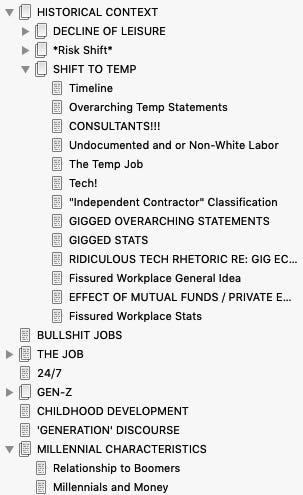gutting a pile of books

This is the face that Peggy has been giving me over the last week — the first of my book leave for what will (eventually) (soon) become the millennial burnout book. The only way for me not to freak out about the prospect of writing a (first draft of a) book in three months is to methodically organize the labor. For the first six weeks, I’m reading like a demon; first the second six weeks, writing. I don’t know how I’m going to organize the writing yet, but if there’s one thing I really, really learned in grad school, it’s how to tackle an ENORMOUS AND EVER-GROWING PILE OF READING ON A DIFFUSE TOPIC.
I’m documenting the books as I go through them here, but they’re currently organized in four piles: Meta/Context (e.g. The Fissured Workplace), Tech/Overload (e.g. How to Do Nothing), Parenting/Relationships (e.g. All Joy and No Fun), and what I’m calling “Airport Books,” or the books that try and tell you how to live/master/handle your life, some of which explicitly address burnout, and others that only implicitly do so. This category expands to include everything from all of those books with F*CK and SH*T in their titles (I’m using the asterisks here because they do) and Girl Wash Your Face.
I’m going through the books in that order, but am also accumulating more books to read — as well as newspaper/magazine articles and academic journal articles. (I save the popular press articles for last, but try to wedge the academic journal articles [which I have access to thanks to a borrowed academic password] in as I go).
My reading process will be familiar to some other academics — it’s annoying but it’s the only way I know that works for me. First off, I don’t closely read every single book — and not just because I’m in a hurry. A lot of academic books in particular are filled with a TON of evidence, which is great because they’re trying to back up their argument, but it’s not always useful for what I’m trying to understanding or contextualize. I read the introduction and first chapter very closely, and start skimming the rest, stopping and slowing down when there’s a chapter or section that’s interesting, underlining as I go, using my favorite brand of pen. (If you’re a pen-particular person, you get it)
Afterwards, I go through and transcribe everything that I’ve underlined, organizing it in folders/subfolders in my sprawling Scrivener document, which is currently organized something like this:

The transcribing is annoying — I’m a fast and accurate typist, which I mostly attribute to playing a game called PAWS on my Apple IIe as a child — but it's also one of the only ways that I actually internalize what I’ve read. Read it once, and it’s notable; read it twice (while also typing it) and it somehow makes a different imprint on your brain. Or, at least, my brain — brains are so weird and personal. Because the fact is, I’m never going to use 90% of the quotes that I’ve transcribed. I might consult 50% of them. But the larger ideas, actually making their way into my head — that’s what matters. (And it just doesn’t work the same, at least for me, when you copy/paste from a Kindle).
Once I finish the transcribing, then I allow myself the pleasure of crossing off the book’s title on my grand list of reading, and then take a picture and tweet about it — which might seem weird, but when you’re spending the bulk of everyday immersed in reading and transcribing, it’s my way of having some way of talking about it outside of my own head.
This is called “gutting” a book — a term that implies more blunt, violent force than how I actually approach it. Sometimes it takes four hours to go through a book (three hours to read, one to transcribe); sometimes it takes seven or eight. The time spent depends far less on the actual length of the book and far more on how good/pertinent the book is. (I know some people don’t like underlining/writing in books, which is something I don’t feel at all, especially when it comes to nonfiction. I set aside a portion of my advance so I could actually buy the books I wanted to read, and it’s been a great pleasure to mark them up, instead of sitting in the library with a sheaf of post-it notes).
Right now, if I were to recommend anything that I’ve read to a normal person who isn’t researching for a burnout book, it’d be Louis Hyman’s Temp, which provides a fascinating look at the development of private equity and consultancy firms whose business models led to the current temp/contingent labor situation.
People have asked me if this is going to be a historical book, a contemporary contextual book, a first person book, a book that relies on reporting/interviews with other people, and the answer is that it’s going to be all of those things — which is what I always aim for with my longer writing. And the first step, which is always my first step, is reading as close to everything as possible — while also putting a time limit on it. This will likely change, but right now, I’m just feeling outrageously lucky to have the ability to read all day — even if the unending stream of reading (and then writing) is absolutely going to give me burnout while writing a burnout book. AT LEAST I’LL HAVE SOMETHING TO WRITE ABOUT IN THE INTRO??!!??
Things I Read and Loved This Week That Had Nothing To Do With Burnout:
“I bought the Fleabag jumpsuit”
Keeping the language of whistles alive in rural Turkey
ilu Randall Park
The Forgotten Story of How Black Psychiatrists Helped Make Sesame Street
A perfect, devastating kicker on this piece about Incels and plastic surgery
This week’s just trust me. Spend some time with it.
Thank you to everyone who responded to last week’s email with some version of “hot priest.” I love you. And if you know someone who’d like this sort of thing in their inbox once a week, forward it their way. You can subscribe here.



